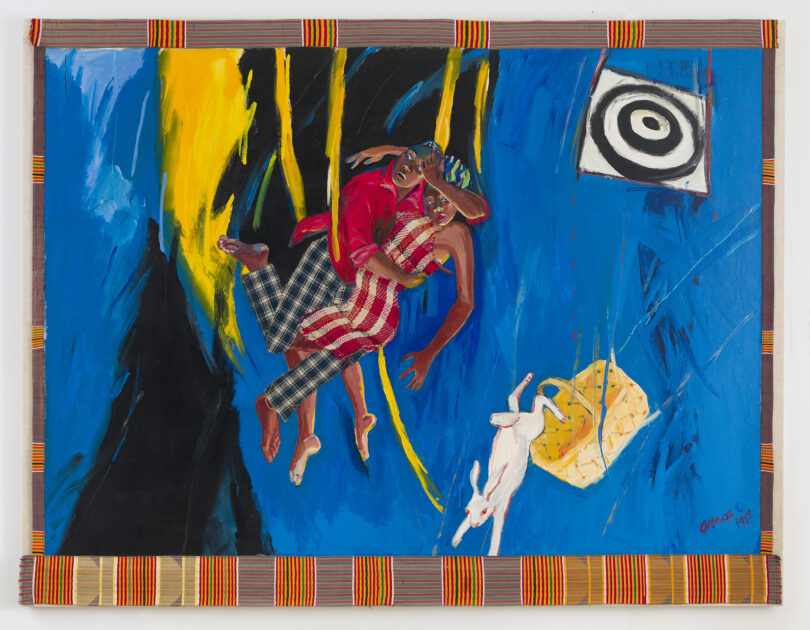“Emma Amos: Color Odyssey” will be on view at the Georgia Museum of Art Jan. 30-April 25. The retrospective solo exhibition shows her presence and growth as an artist, but also highlights the social change for which she fought.
The exhibition, organized by the Georgia Museum of Art at the University of Georgia, includes over 60 works Amos made over the course of her career, with the earliest from the late 1950s and the latest around 2015. It includes examples of painting, printmaking and textile-based mixed-media works, which she moved among and recombined regularly.
Amos’s journey to become a distinguished artist is nothing short of extraordinary. She was interested in art from a young age, even though segregation prevented her from being able fully to enjoy and experience the arts in museums and other public “separate-but-equal” spaces.
Amos was the only woman in Spiral, a group of Black artists who came together to examine their relationship with art and activism. They often disagreed on key topics, usually regarding if and how they should address social issues as a group and within their art. Some members, including Amos, did not like separating “Black” art from all other art, but others saw no purpose in continuing Spiral if not to perpetuate the growth of the Black art scene. To Amos, being Black was a political statement, but she wanted to address various issues regarding race, gender, class, and power within the art world and in society as a whole, not just the adversities of Black people. After her death, it was even revealed that she was also a member of the Guerilla Girls, a feminist art collective whose members wear masks to keep their identities anonymous. Amos actively fought against misogyny in the art world and evolved as a feminist artist sensitive to the nuances of race, age and class-oriented politics of her time through her teaching and writing but most of all her art.
Amos knew that like many other artists of color, she would not receive immediate recognition by the art community. During the 2010s, she received a surge of attention due to participation in major traveling exhibitions. In 2016, the Georgia Museum of Art honored her with its Larry D. and Brenda A. Thompson Award. Shawnya L. Harris, Larry D. and Brenda A. Thompson Curator of African American and African Diasporic Art, had gotten to know Amos and had already began to work on her as the subject of an expansive exhibition.
“Amos is one of several Black women artists whose contribution to art history deserves attention and critique,” Harris said. “Putting together several decades worth of her work provides a special opportunity to learn more about her career, techniques and ideas, inviting re-evaluation and new audiences in relation to her artistic progression.” Amos died in May 2020, but her legacy lives on in the art she created and the contributions she made to a better society.
The museum is publishing a scholarly exhibition catalogue to accompany the show, with essays by Harris; Lisa Farrington of Howard University; artist LaToya Ruby Frazier; Laurel Garber, Park Family Assistant Curator of Prints and Drawings at the Philadelphia Museum of Art; artist Kay Walkingstick; and Phoebe Wolfskill, associate professor in the departments of American studies and African American and African Diaspora studies at Indiana University.
“Emma Amos: Color Odyssey” is sponsored by the National Endowment for the Arts, the Willson Center for Humanities and Arts, the W. Newton Morris Charitable Foundation and the Friends of the Georgia Museum of Art.
Related events during the course of the exhibition include:
- A virtual discussion with curator Shawnya Harris and other scholars, artists and curators on Feb. 4 at 4 p.m.
- Family Day To-Go: Color Odyssey, with free art kits that can be picked up at the museum Feb. 11-14 (while supplies last). Family Day is sponsored by Heyward Allen Motor Co., Inc., Heyward Allen Toyota and the Friends of the Georgia Museum of Art.
- This year’s Emerging Scholars Symposium: “Visualizing Identity: Exploring Dimensions of the Self through Art” (Feb. 18-20)
- Toddler Tuesday To-Go: Color Adventures on Feb. 23, with a storytime video and a related art activity, posted on the museum’s Art at Home page
- An Artful Conversation with Callan Steinmann, curator of education, leading close looking and conversation about selected works from the exhibition on Zoom on March 17 at 1 p.m.
- And a Teen Studio via Zoom, on March 25 at 5:30 p.m. for ages 13-18. This program is free, but art supply kits are limited. Email sagekincaid@uga.edu to register.
The exhibition will next travel to the Munson-Williams-Proctor Arts Institute from June 19 to Sept. 12, and the Philadelphia Museum of Art from Oct. 9 to Jan. 2, 2022.









